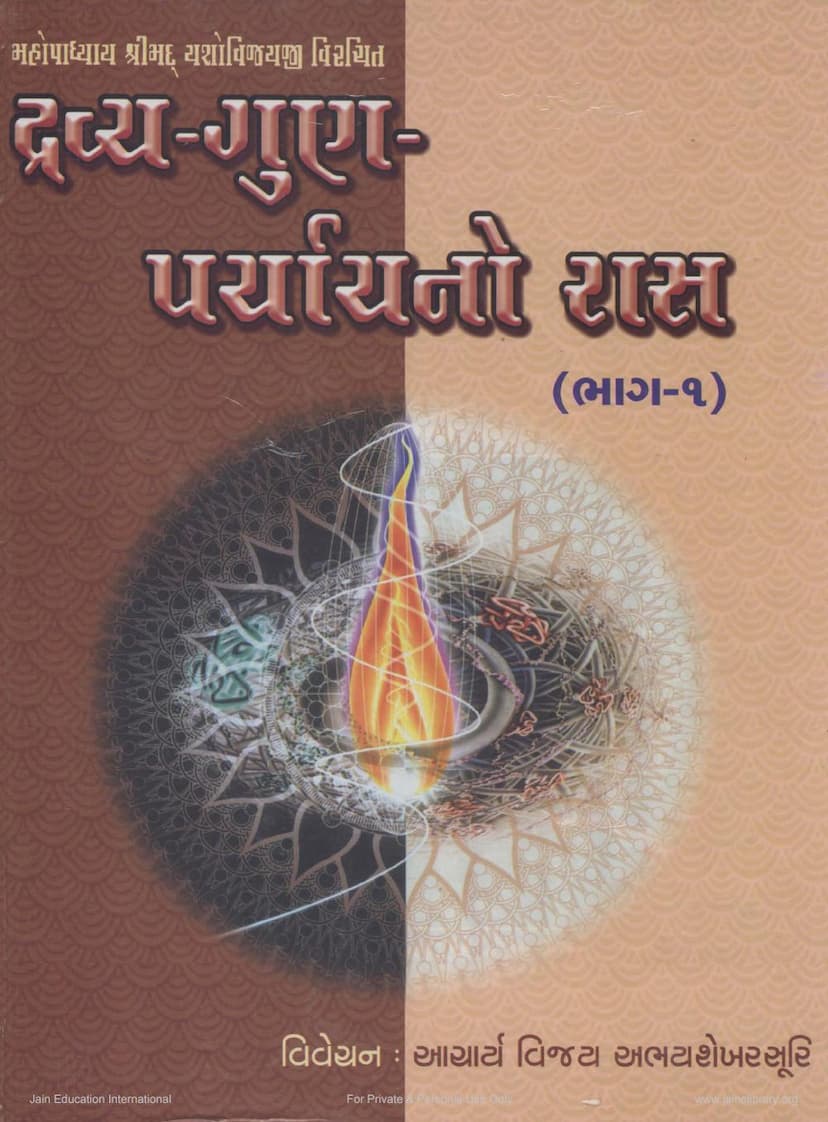Dravya Guna Paryaya No Ras Part 01
Added to library: September 1, 2025

Summary
Here's a comprehensive summary of the Jain text "Dravya Guna Paryaya no Ras Part 01" by Abhayshekharsuri, based on the provided pages:
Book Title: Dravya Guna Paryaya no Ras Part 01 (द्रव्य-गुण-पर्याय नो रास भाग-१) Author: Mahopadhyaya Shrimad Yashovijayji Ganivar (महोपाध्याय श्रीमद् यशोरविजयाजी गणिवर) Commentary/Explanation: Acharya Vijay Abhaysekharsuri (आचार्य विजय अभयशेखरसूरीश्वरजी म.सा.) Publisher: Divya Darshan Trust (दिव्यदर्शन ट्रस्ट)
Overall Purpose: This book is the first part of a commentary (Vivechan) on the work "Dravya Guna Paryaya no Ras" by the renowned Jain philosopher Mahopadhyaya Yashovijayji. The commentary is authored by Acharya Vijay Abhaysekharsuri, aiming to elucidate the profound philosophical concepts of Dravya (Substance), Guna (Attributes), and Paryaya (Modes) as presented by Yashovijayji. The aim is to bring forth the deep, often subtle, meanings hidden within Yashovijayji's work, making it accessible to contemporary readers, particularly the youth.
Key Figures:
- Mahopadhyaya Shrimad Yashovijayji: The original author of "Dravya Guna Paryaya no Ras," a highly respected Jain scholar and philosopher.
- Acharya Vijay Abhaysekharsuri: The commentator and editor of this work, a prominent modern Jain scholar known for his logical acumen and deep study of Jain philosophy. He is a disciple of Acharya Vijay Bhuvanbhanusurishwarji.
- Acharya Vijay Premsoorishwarji: The spiritual predecessor and guru of Acharya Bhuvanbhanusurishwarji, credited with the consecration of the Shri Munisuvratswami deity in Kolhapur.
- Acharya Vijay Bhuvanbhanusurishwarji: A revered figure, mentor to Acharya Abhaysekharsuri, and a proponent of Jain knowledge dissemination through various means like the weekly "Divya Darshan."
- Pandit Ajitshekhar Vijay: The esteemed scholar who has provided the preface (Prastavna) to this commentary, further highlighting the significance of the work and the commentator's expertise.
Content and Philosophical Focus (Based on the provided introductory pages and table of contents):
The commentary focuses on explaining the fundamental Jain concepts of:
- Dravya (Substance): The text delves into the nature of substance, its definition, and its relative permanence versus change. It discusses how the understanding of Dravya is crucial for grasping the Jain viewpoint.
- Guna (Attributes/Qualities): The commentary explores the inherent qualities that exist in substances. It distinguishes between permanent attributes (which exist in all modes) and temporary attributes. The text seems to engage with the idea that qualities themselves might be considered modes (Paryaya) in a certain context, a subtle philosophical point.
- Paryaya (Modes/States): The text examines the transient states or modifications that a substance undergoes. It highlights how Paryayas are essential for understanding the dynamic nature of reality and how they relate to the underlying substance and its attributes.
Commentary Style and Approach: Acharya Abhaysekharsuri's commentary is characterized by:
- Logical Acumen (Tarkanusari): The explanations are grounded in rigorous Jain logic and dialectic.
- Scriptural Accuracy (Shastranusari): The commentary adheres strictly to the principles and pronouncements found in the Jain Agamas and other foundational scriptures.
- Deep Contemplation (Anupreksha): The explanations are the result of deep, insightful contemplation and analysis of the subject matter.
- Clarity and Depth: The goal is to reveal the hidden secrets and profound insights within Yashovijayji's original work, making complex topics understandable.
- Respect for Tradition: The commentary acknowledges and respects the insights of previous scholars while offering its own profound elucidations.
- Comprehensive Research: The commentary is noted for its thorough research, including detailed word-by-word and line-by-line analysis, and reference to various philosophical schools (Jain and non-Jain) to clarify points.
- Textual Purity: Acharya Abhaysekharsuri has diligently worked on purifying the text, referring to various manuscripts and scholarly opinions to establish the most accurate readings, ensuring the commentary is authentic and reliable.
Structure and Key Themes Explored (Indications from the Table of Contents): The first part of the commentary covers:
- Mangalacharan (Auspicious Invocation): Beginning with veneration to the enlightened ones and the author's gurus.
- Discussion on Dravya: Defining substance, its relative nature, and the philosophical debate around "what constitutes substance?"
- Guna and Paryaya: Elucidating their characteristics and relationship with substance.
- The Concept of "Paryaya" and its Nuances: This includes detailed discussions on concepts like:
- The nature of "Paryaya" and its relation to substance and attributes.
- The four types of "Anuyoga" (categorization of discourse).
- The significance of "Dravyanuyoga" in achieving spiritual progress.
- The relationship between "Paryaya" and "Guna," exploring whether qualities are themselves modes.
- Discussions on different types of "Paryaya" like "arthaparyaya" (meaningful modes) and "vyanjanaparyaya" (linguistic modes).
- Detailed analysis of "Saptabhangi" (the sevenfold assertion of anekanta vada), a key Jain logical tool for understanding reality's multifaceted nature.
- The interplay between "Naya" (standpoints) and "Pramana" (means of valid knowledge).
- Analysis of different types of "Naya" (like Naigama, Sangraha, Vyavahara, Rujusutra, Shabda, Samabhirudha, Evambhuta) and "Upanaya" (like Sadbhuta, Asadbhuat, Upacharitasadbhuat), critically examining their definitions and scope, especially in relation to different Jain schools of thought (Shvetambara vs. Digambara views).
- The philosophical underpinnings of "Dravya," "Guna," and "Paryaya" in relation to the ultimate goal of liberation (Moksha).
Overall Significance: This commentary is presented as a valuable contribution to Jain literature, aiming to make the profound philosophical teachings of Mahopadhyaya Yashovijayji accessible and understandable to a wider audience. It emphasizes the importance of intellectual engagement and logical reasoning in understanding the Jain path to liberation, highlighting the interconnectedness of Dravya, Guna, and Paryaya as central to spiritual realization. The commentary is dedicated to the spiritual lineage of the authors and the supporting trusts, underscoring the collaborative effort in preserving and propagating Jain knowledge.